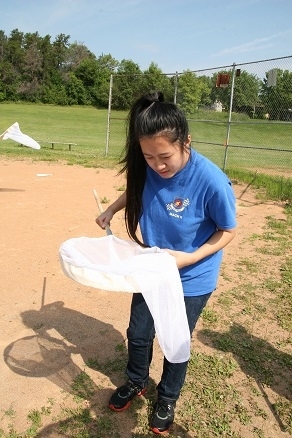- A group opportunity. Invite your friends.
-
17 people are interested
Wasp Watchers finding Emerald Ash Borer!
ORGANIZATION: Wasp Watchers Program, University of Minnesota
Please visit the new page to apply.
- A group opportunity. Invite your friends.
-
17 people are interested

Wasp Watchers in looking for volunteers to help monitor Smoky winged beetle bandit wasp, Cerceris fumipennis, nesting sites. These wasps hunt and capture wood boring beetles including Emerald Ash Borer (EAB). With the help of these wasps, we can detect EAB infestations early. Early detection is the key to controlling these invasive beetles. Find out more information at the Wasp Watchers website. We need volunteers to: Visit your adopted site 4-6 hot, sunny afternoons in July and early August. Visit site during Beetle bandit peak flight time; between 10am and 4pm. Count nests. Beetle bandits are solitary wasps, but the females nest close to each other. There can be 5-100 nests in one area. Gather dropped beetles. Beetle bandits often abandon their prey if they are threatened or think that their prey is somehow damaged. You can often find these abandoned beetles near the nesting sites. Collect these dropped beetles in a vial and label your findings. For 1-3 hours monitor nests for returning wasps. Observe as many nests as you can watch. Watch for wasps coming in with prey. You will soon be able to recognize the bottom-heavy silhouette and slow, heavy flight of a wasp with prey. Gently net the wasp returning with prey. Use a lightweight mesh net so you do not hurt the wasp. The shock of netting will usually cause the wasp to drop her prey. Place captured beetles in a vial and label your findings. Collect a total of 50 beetles over 4-6 visits. Rule of thumb: Capture the equivalent (or less) of one beetle per wasp hole per search day. Place all beetles in label vials (provided by the U of MN) and put into freezer until the end of the summer. After each collection day, enter your data at the Wasp Watchers website. In the fall, send the collected beetles to the University of Minnesota in a postage paid box for identification.
More opportunities with Wasp Watchers Program, University of Minnesota
No additional volunteer opportunities at this time.
About Wasp Watchers Program, University of Minnesota
Location:
Entomology Department, 219 Hodson Hall, 1980 Folwell Ave., St. Paul, MN 55108, US
Mission Statement
The mission of the Wasp Watchers Program is to engage citizen scientists for Emerald Ash Borer biosurveillance as a tool for early detection of this invasive beetle in Minnesota’s ash trees.
Description
The Wasp Watchers Program through the University of Minnesota Extension engages citizen scientist volunteers to help with the early detection of emerald ash borer infestations using a biosurveillance tool. The Smoky winged beetle bandit wasp, Cerceris fumipennis, is a harmless native wasp that specializes in hunting metallic wood boring beetles including Emerald Ash Borer. These wasps are not known to sting people, even when handled. Female wasps forage for beetle prey in trees and bring them back to ground nests as food for their offspring. Volunteers monitor the nests of non-stinging, ground nesting wasps and capture their beetle prey. Captured beetles are sent to the University of Minnesota Entomology Department for identification. If EAB is in your area, these wasps will find it for us!
CAUSE AREAS
WHEN
WHERE
Local baseball/softball fieldsThroughout Minnesota,St. Paul, MN 55108
DATE POSTED
March 9, 2016
SKILLS
- Environmental Education
- Environmental Policy
- Environmental Science
- Animal Care / Handling
- Habitat Restoration
- Gardening
GOOD FOR
- Kids
- Teens
- People 55+
- Group
REQUIREMENTS
- Must be at least 6
- 1-2 hours a week for 6 weeks in the summer
- Youth participants are welcome with adult supervision. Transportation to sites is required.
